DAVID CARL "DAVEY" ALLISON - 2/25/1961 - 7/13/1993
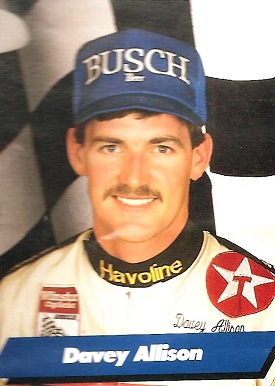
Growing up, Allison participated in athletics, preferring football, but settled upon automobile racing. He began working for his father's NASCAR Cup Series team after graduating high school, and built a race car of his own, a Chevy Nova, with friends known as the "Peach Fuzz Gang". He began his career in 1979 at Birmingham International Raceway and won his first race in his sixth start. He became a regular winner at BIR, and by 1983 was racing in the Automobile Racing Club of America (ARCA) series. Allison won two ARCA events at his home track, Talladega Superspeedway, in 1983, and was named ARCA Rookie of the Year in 1984, placing second in the series title. He also made his first Xfinity start in 1983. It came at Rockingham when he would wheel the unsponsored #23 owned by Bobby Allison. In 1984, he married his first wife, Deborah. Allison continued racing in the ARCA series in 1985, winning eight races in the series, four at Talladega Superspeedway. He competed in some of NASCAR's lower divisions. In the Xfinity series, his crew chief was Red Farmer. In July 1985, car owner Hoss Ellington gave Allison an opportunity to drive a NASCAR Cup Series car in the Talladega 500. Allison qualified 22nd In Ellington's Chevrolet and finished 10th in his first Cup start driving the #1 Lancaster Chevrolet. Prior to the 1987 season, car owner Harry Ranier tapped Davey to replace veteran driver Cale Yarborough in the Ranier-Lundy #28 Ford
Thunderbird. Yarborough was leaving the Ranier-Lundy team to start his own operation along with the team's sponsor, Hardee's. Ranier negotiated a sponsorship deal with Texaco's Havoline motor oil brand, a deal that was signed during the NASCAR edition of Speedweeks at Daytona International Speedway. On qualifying day, Davey signaled that he was in Cup to stay when he qualified an unmarked, but Texaco-Havoline painted #28 Thunderbird second for the 1987 Daytona 500, becoming the first rookie ever to start on the front row for NASCAR's most prestigious event. A pit miscue which allowed a rear tire to fall off on the track ended his hopes of a good finish in the race, but success for Davey Allison would be just around the corner. May 3, 1987 would become an infamous day in NASCAR history. Earlier in the week, Bill Elliott had qualified his #9 Coors-Melling Ford Thunderbird at a record 212.809 mph (a record which still stands today) for the Winston 500. Davey Allison would qualify third, while father Bobby would start second alongside Elliott in the

First ARCA win - Talladega 1983
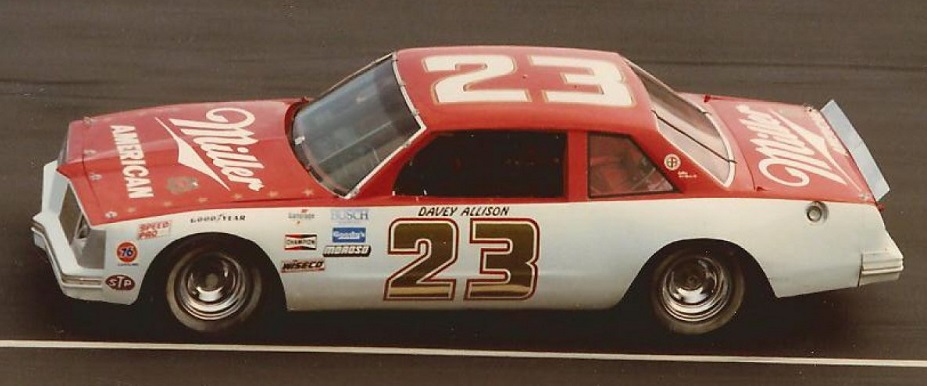
First Xfinity start Rockingham 1983
Stavola Brothers #22 Miller Buick. On lap 22 of the event, Bobby Allison ran over a piece of debris, cutting his right-rear tire. The car turned sideways, lifted into the air, became airborne, and crashed vertically into the front stretch spectator fence near the start finish line. The car landed back on the track and collected a number of other competitors. Davey was ahead of his father at the time and saw the crash unfold in his mirror. Bobby Allison was not injured. The race was red-flagged for two hours and thirty-eight minutes. It was this event that triggered the
requirement of smaller carburetors, and later, carburetor restrictor plates on engines at Daytona and Talladega to reduce the top speeds. When the race resumed, Allison continued to run up front and when Elliott exited the race with engine failure, his toughest competition was eliminated. With darkness falling during a late caution flag, the decision was made to end the race 10 laps short of its 188 lap distance. Running second on the restart, Allison passed leader Dale Earnhardt on the backstretch and pulled away for his first Winston Cup win. In winning the race, Allison became the first rookie since Ron Bouchard in
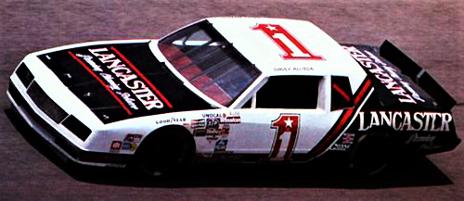
First Cup start 1985 Talladega

First Cup win 1987 Talladega
1981 to win a Winston Cup event. Allison would better that feat just 28 days later by winning the Budweiser 500 at Dover International Speedway. The 1988 season started with much promise. Allison again started outside the front row for the Daytona 500, the first modern day race utilizing the NASCAR-mandated carburetor restrictor plate. While father Bobby was battling up front early in the race, Davey and his team struggled with a car that was repaired during the early morning hours following a crash in the final practice session. As the race came to a conclusion, Davey found himself running second, just behind his father.
Bobby Allison would go on to hold off his son and win his third Daytona 500. Father and son would celebrate their one-two finish in victory lane. Davey Allison would struggle through much of the first half of the 1988 season as he ran some of the Winston Cup short tracks for the first time. Then on June 19, at Pocono International Raceway came his father's near-fatal, career-ending crash. With his father clinging to life in a Pennsylvania hospital, Davey Allison raced on but failed to finish the next three events. Allison would score his first win of the season at Michigan International Speedway. The win changed the fortunes for the financially strapped team and after a series of top-5 and top-10 finishes, Allison would win the inaugural race at the new Richmond International Raceway. On October 1, 1988, Ranier sold the team to Yates, who temporarily remained as Allison's crew chief for the balance of the season, before undertaking full ownership. The rest of the season was a mixed bag, but Allison would finish the season with a third-place finish at Phoenix International Raceway, and a second at the season ending Atlanta Journal 500. But the roller coaster 1988 Winston Cup season had taken a toll on Davey Allison's marriage and he and Deborah quietly divorced during the offseason. In 1989, Davey started on the pole at Talladega and got his first win of the season, his second victory in Talladega's spring event. Davey would marry his second wife, Liz, during the season, and their first child, Krista, was born prior to the 1990

Bobby 1988 Daytona 500 winner douses second place finisher, son Davey Allison
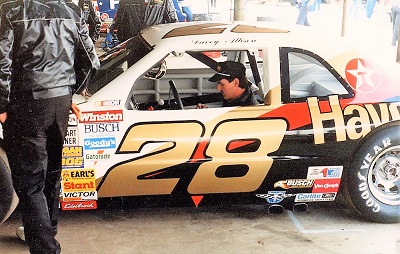
season. The 1990 season did not start much better than the 1989 season and by the sixth race at Bristol, Davey was a 17th in the Cup standings. A poor qualifying run had the team pitting in the backstretch pits, which usually doomed a team's chances of winning the race. But Robert Yates decided against pitting on the final caution flag and Davey scored his second short-track win in a thrilling photo-finish with Mark Martin, winning by just eight inches. The 1991 season began with much promise. But a late race accident left Allison finishing 15th. Things went downhill. Davey was openly feuding with crew chief Elder, and Allison threatened to quit the team if Elder stayed. After the poor result at Atlanta, Robert Yates decided that he had to make a change at crew chief. Elder was
fired, and Larry McReynolds was hired away from the Kenny Bernstein team to replace him. In his first race with McReynolds at the helm, Allison finished second at the 1991 Transouth 400. A third-place finish followed at Bristol, then a sixth at North Wilkesboro and an eighth at Martinsville. The team finished 22nd at Talladega due to a large accident triggered by Ernie Irvan but there was no doubt the team was much improved and was destined for bigger things. Two weeks later, Davey dominated The Winston all-star race at Charlotte, and continued his domination by winning the Coca-Cola 600 the following week, leading 263 of the race's 400 laps. The final tally of the 1991 season for Davey Allison; five wins, 12 top-five and 16 top-ten finishes. It was also during the 1991 season that Davey and Liz welcomed their second child, a son, Robert Grey Allison. With Larry McReynolds at the helm, Davey Allison entered the 1992 season as a legitimate championship contender. Statistically, 1992 was Davey Allison's best season in Winston Cup racing. Davey
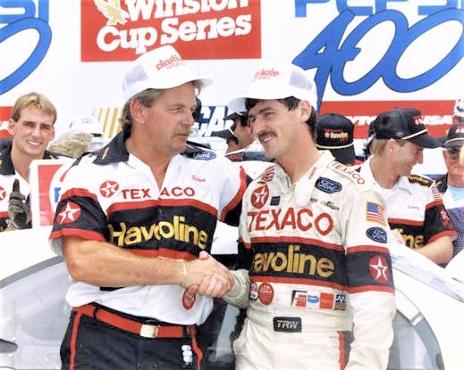
Allison & Doug Yates in victory Lane 1989 Daytona
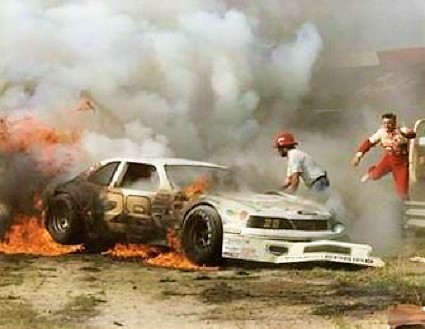
Bobby Allison running to Davey's car Pocono
started sixth in the 1992 Daytona 500 but was probably not quite as fast as the Junior Johnson teammates of Bill Elliott and Sterling Marlin. But the race would change dramatically on lap 92 when Elliott, Marlin, and Ernie Irvan triggered a multi-car crash at the front of the pack. Fourteen cars were eliminated, but Allison—and eventual runner-up Morgan Shepherd—somehow made it through the mess. He would dominate the event, lead 127 laps to join his father as a Daytona 500 winner. Bill Elliott would rebound to win the next four events, but Allison was not far behind in each event, posting four top-five finishes to maintain his lead in the points. One year removed from his domination of the All Star race and the Coca-Cola 600, Davey was ready to take the spotlight again. But this time around, there was more focus on the event itself. In the third turn on the final lap, Petty got under Earnhardt's car and the GM Goodwrench Chevrolet spun. Davey took advantage of this and jumped into the lead. But Petty charged back and as Davey crossed the start-finish line to
win the race, the two cars came together, sending the driver's side of Davey's car hard into the outside wall in a shower of sparks. An unconscious Allison was taken from his car and airlifted to a Charlotte hospital. The crash left him with a concussion, bruised lung, and a battered and bruised body. Allison and Elliott continued their drive for the championship all season as the two kept pace with each other. Elliott had opened a 100 point lead, but as the season would down it began to slip. Elliott's skid stopped temporarily at Rockingham where he finished fourth. Davey finished 10th and Kulwicki 12th and entering the final two races of the 1992 season, Davey was 70 points behind Elliott in second, with Kulwicki 85 points behind in third. But Davey's fortunes changed dramatically at Phoenix as he won the event by beating his closest rivals off of pit road, and Elliott finished 31st. Davey now had the points lead for the first time since early in the season. He was 30 points ahead of Kulwicki, and 40 ahead of Elliott, who had slipped to third in the standings. Also in contention to win the championship as the series moved to the final race at Atlanta were Harry Gant (fourth place, 97 points behind), Kyle Petty (fifth place, 98 points behind), and Mark Martin (sixth place, 113 points behind). The 1992 Hooters 500 would be a milestone race in NASCAR Winston Cup history. It would be the final race of Richard Petty's career, as well as the first for future Cup Champion Jeff Gordon. Couple that with the closest championship race in history, and the race was destined to be a classic. Davey Allison entered the race needing only to finish fifth or

1991 All Star Winner
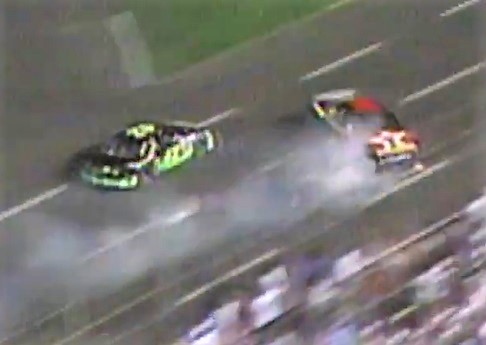
Petty & Allison tangle at checkers 1992 All Star race
better to win the Cup title. Meanwhile, Elliott and Kulwicki were staging a battle for the ages, battling for and swapping the lead through much of the event. Late in the race, Davey had finally managed to reach the top five and was in position to win the championship when Ernie Irvan lost control of his car on the frontstretch on lap 286. Davey could not avoid Irvan's spinning car and plowed into the #4 Kodak Chevrolet Lumina. Allison's tumultuous 1992 season was over, his championship hopes lost as Elliott and Kulwicki finished first and second in the race respectively. Kulwicki, an independent driver who had turned down offers to drive for other teams, including Junior Johnson, won the championship by leading one more lap than Elliott (103 to 102). 1993 opened on a sour note with Allison finishing 28th at Daytona. That finish was followed by a 16th at Rockingham, but Davey rebounded to win at Richmond the following week. Prior to the Bristol, Kulwicki
was killed in a small plane crash, in bad weather, returning to Bristol after a publicity event in Knoxville. Three days after Kulwicki's death in an airplane crash, Davey Allison finished fifth in an emotional race at Bristol. On July 12, 1993, Allison boarded his newly acquired Hughes 369HS helicopter to fly to Talladega Superspeedway to watch family friend Neil Bonnett, and his son David Bonnett test a car for David's Xfinity Series debut. He picked up another family friend, racer Red Farmer, en route to the track. Allison was attempting to land the helicopter inside a fenced-in area of the track infield when the craft nosed up suddenly, then crashed. Neil Bonnett freed the semi-conscious Farmer from the wreckage, but Allison was unresponsive and could not be freed until paramedics

1992 IROC win
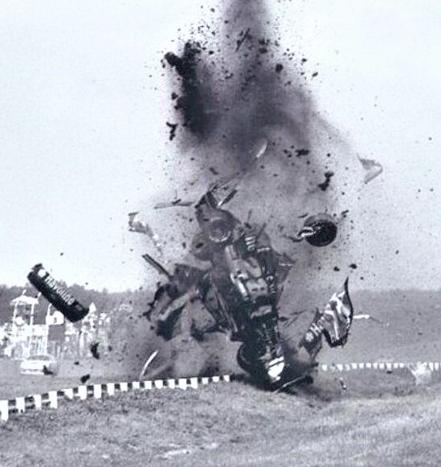
1992 Pocono crash
arrived. Farmer went on to a lengthy but successful recovery, but Allison never regained consciousness after sustaining a critical head injury. He was pronounced dead at 7:00 a.m. the next morning by a neurosurgeon. In early 1994, Allison's estate filed a lawsuit against McDonnell-Douglas claiming the cause of the crash was a failure of the collective yoke on the helicopter. Birmingham attorney Jim Thompson presented evidence from a metallurgist showing that the cast metal piece contained air pockets and paint inside the part, claiming “that meant the part was defective the day it left the factory.” A test pilot reconstruction showed identical results to Allison's crash. McDonnell-Douglas and the Allison estate reached a confidential settlement out of court in early 1996. In his short NASCAR Cup career, Allison posted 19 wins, 66 top-five finishes, and 92 top-ten finishes. He also won 14 poles and earned $6,724,174. He was also Rookie of the Year in 1987. All of his wins came driving the #28 Ford. He was survived by his wife, Liz, and two children: daughter Krista Marie and son Robert "Robbie" Grey.
Talladega fatal helicopter crash 1993 ------>

All Photos copyright and are property of their respective owners
